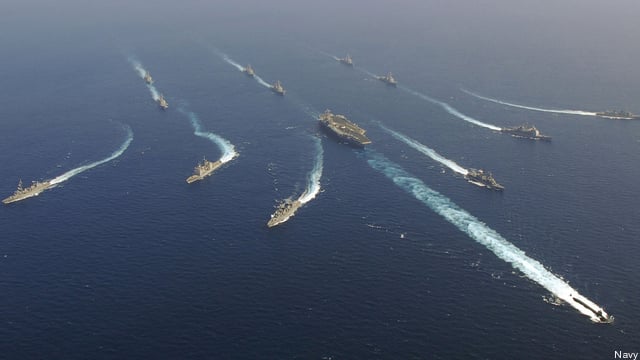A Better Fleet: Scrap LCS, Double Virginia Sub Buy & Move Design Back To Navy
Posted on

The US Navy needs more ships. The United States cannot protect the world’s sealanes, let alone “pivot to the Pacific,” if we further downsize our military. Especially given other nations’ growing anxiety about whether the US will still shoulder the leadership role of protecting them, the Navy must grow, not become smaller.
Yes, individual ships may be more capable today than in the past, but the harsh reality is that even the most high-tech ships are useless unless the U.S. maintains enough of them to sustain a forward deployed presence in hot spots around the world.
There are several key steps the Navy can take to reinvigorate a strong maritime presence around the globe:
The nation needs a new naval strategy that clearly links national interests to the the naval assets required to protect those interests and that justifies the size of the fleet required to keep America safe. While budget limits will ultimately affect the size and mix of the fleet, Americans deserve to know the risk being taken by the nation by relying on a budget-driven Navy to justify the number of ships, aircraft, and submarines used to defend them. A well-defined strategy will show how and why the country should be protected with a larger Navy and why that larger Navy is in the national interest.
Reorganize, reprioritize, and revitalize the Navy’s shipbuilding program and better equip ships for missile defense. A good start would be to bring the design of Navy ships back into the Navy. The Navy-designed DDG-51 Arleigh Burke destroyer is the most successful shipbuilding program today and continued DDG-51 production with the new Air and Missile Defense Radar (AMDR) will ensure flexibility for fleet protection and ballistic missile defense critical to the nation’s security at home and abroad. Currently deployed radars, such as the SPY-1, increasingly struggle against operational threats – including anti-ship ballistic missiles and supersonic, anti-ship cruise missiles – and are severely challenged when these threats are encountered simultaneously. AMDR would fill that gap.
Stop production of the Littoral Combat Ship, pay off the contracts, and immediately fund the design and building of a guided missile frigate replacement. The Virginia-class submarine program should double in production to compete with the resurgent threat from Russia and the growing capability of China’s submarine fleet. Additionally, the Ohio-class ballistic missile submarine replacement, aka SSBN(X), should be placed on the fast track for development and operational fielding.
Maintain and expand the aircraft carrier fleet. Using an updated maritime strategy as the linchpin, keep the current fleet of 10 carriers and speed production of the Gerald Ford-class carriers. These ships a true long-term investment: the Navy sold the $4 billion to $6 billion Nimitz-class aircraft carriers to the American people with a life expectancy of 50 years, but USS Enterprise was only recently decommissioned after 60 years of service. Immediately restore funding for the refueling and complex overhaul of USS George Washington, as well as maintain funding for the airwing, operations and maintenance accounts, and ensure the ship is fully manned. Plan to do the same for USS Stennis in FY2018.
Fully fund and update the Navy’s manpower accounts. Every ship that operates and deploys today is undermanned, undertrained, and underequipped. Provide stabilized manning on ships from six months prior, until completion of deployment. If people are the Navy’s best asset, don’t accept a lowered standard of operational effectiveness due to manning shortfalls. It endangers the ability of the Navy to fight as a team at sea and win.
Cut the number of flag officers and civilian counterparts by 50 percent. In World War II, the Navy had approximately 4,000 ships that fought a global war for freedom with about 100 admirals in charge. Today, there are over 300 admirals overseeing about 280 ships. This unnecessary bureaucratic expansion has diluted the lines of accountability and weakened the chain of command.
History is replete with examples of the president asking, “Where is the closest aircraft carrier?” when faced with an international crisis. Even as recently as the 9/11 attacks, the first military assets to conduct combat operations against the enemy were launched from Navy aircraft carriers and ships in the battle group. A global naval force, built with the numbers and capability to sustain operations forward deployed to the world’s hot spots will serve as a deterrent force and stabilizer for peace and security.
The author, a retired US Navy Commander, was in command of the USS Cole when it was attacked by al-Qaeda in October 2000.
Subscribe to our newsletter
Promotions, new products and sales. Directly to your inbox.
